The Siren’s Call: Understanding the Psychological Impact of Mythical Water Creatures
I. Introduction
Throughout history, mythical water creatures have captivated human imagination, featuring prominently in folklore across various cultures. From the enchanting sirens of Greek mythology to the alluring mermaids of European tales, these beings embody a rich tapestry of meanings and emotions. Understanding their psychological impact is crucial for exploring deeper human experiences related to temptation, beauty, and danger.
This article aims to delve into the complex relationship between these mythical creatures and their psychological implications, providing insights into how they resonate with individuals and cultures alike.
II. Historical Context of Mythical Water Creatures
The origins of sirens and mermaids can be traced back to ancient mythology, each culture offering its unique interpretation:
- Sirens: In Greek mythology, sirens were depicted as dangerous yet alluring creatures who lured sailors to their doom with their enchanting songs.
- Mermaids: Many cultures, including European and Asian, portray mermaids as beautiful beings who inhabit the sea, often symbolizing both seduction and peril.
Cultural variations showcase the duality of these creatures; some are seen as benevolent, while others are viewed as malevolent. Over time, their representations have evolved in literature and art, transitioning from ominous figures to symbols of romantic allure.
III. Symbolism of Water in Psychology
Water holds a significant place in psychological symbolism, representing various aspects of the human experience:
- Unconscious Mind: Water often symbolizes the unconscious, representing deep emotions and hidden desires.
- Nurturing vs. Destructive: While water can nourish and sustain life, it can also destroy, reflecting the duality of human emotions and experiences.
Psychological theories often associate water imagery with emotional states, exploring how these symbols manifest in dreams and narratives. This interplay between water and psyche underscores the complexity of human emotions and relationships.
IV. The Allure of the Siren’s Call
The concept of temptation is central to the narratives surrounding sirens and mermaids:
- Desire and Danger: The seductive songs of sirens symbolize the allure of temptation, often leading to perilous consequences.
- Fantasy in Psyche: These stories tap into the human tendency to fantasize about unattainable desires, reflecting deeper psychological truths about longing and risk.
Such narratives serve as metaphors for real-life temptations, illustrating the struggle between desire and self-preservation that individuals face in their own lives.
V. The Siren Archetype in Modern Culture
In contemporary media, the representation of sirens and mermaids continues to shape societal perceptions:
- Media Representations: Films, literature, and art frequently depict sirens and mermaids as symbols of beauty, often influencing societal standards of femininity.
- Psychological Analysis: The siren archetype is analyzed in popular psychology, exploring its implications on self-image and the understanding of femininity.
This ongoing fascination with the siren archetype reflects broader cultural narratives about gender, beauty, and power, inviting critical examination of how these themes resonate in our lives.
VI. Psychological Effects on Individuals
The influence of mythical water creatures can be profound, as illustrated by various case studies:
- Individual Narratives: Many individuals report feelings of empowerment or entrapment when engaging with the stories of sirens and mermaids, revealing the complexities of these archetypes.
- Metaphor for Temptation: The siren’s call serves as a metaphor for real-life temptations, such as unhealthy relationships or addictive behaviors.
Coping mechanisms and psychological resilience are essential in navigating these temptations, highlighting the importance of self-awareness and personal growth in overcoming challenges.
VII. Therapeutic Applications of Myth and Narrative
Mythical creatures can play a significant role in therapy and counseling:
- Therapeutic Integration: Utilizing myths and narratives can help individuals explore personal struggles, providing a framework for understanding complex emotions.
- Role of Storytelling: Storytelling allows individuals to connect with their experiences, facilitating healing and personal insight.
Integrating mythology into psychological practices fosters a richer understanding of the human condition, encouraging exploration of one’s own narrative in relation to these timeless archetypes.
VIII. Conclusion
In summary, mythical water creatures such as sirens and mermaids hold significant psychological meaning, reflecting deep-seated human emotions and desires. Their allure and danger serve as metaphors for temptation, highlighting the complexities of the human experience.
The ongoing relevance of these creatures in psychology invites further exploration of their impact on mental health and well-being. By examining the intersection of mythology and psychology, we can gain deeper insights into our own lives and the narratives that shape our understanding of self and society.




